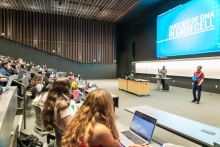
Created by Microsoft Co-Pilot
ChatGPT and other forms of generative artificial intelligence (AI) are booming. As instructors, its is important to consider what generative AI means for your teaching. What are the expectations for the use of AI in your course and how are you communicating that to your students?In other words. what is your AI usage philosophy? This guide is an evolving set of resources curated for you to help support your discussion of generative AI, like ChatGPT, in your class.
This content was co-developed with the UC Santa Barbara and UC Berkeley Centers for Teaching and Learning and ChatGPT (OpenAI's GPT-3.5, 2023). At UC Merced, feel free to get in touch with faculty who use ChatGPT in their classes, like Sylvain Masclin at smasclin@ucmerced.edu
What is Generative AI
Generative AI such as ChatGPT, GPT-4, Bard, DALL-E 2, and Midjourney, is a rapidly evolving content creation technology. As these tools advance, we can expect to see more innovative applications that leverage the creativity and generative capabilities of AI. However, it is crucial to approach the use of generative AI responsibly and address ethical considerations surrounding its applications, such as misinformation and potential biases. Need more guidance on AI's opportunities and threats in the classroom?
Consider this document which links a series of talks from a symposium at UC San Diego covering academic integrity, assessment, and a student panel.
Main Takeaway: Communicate Expectations to Students
Whatever your position and subsequent decision about the use of AI that you make as an instructor, explain why you made this decision for your class. Have an open and honest conversation with your students about using generative AI responsibly and ethically. Encourage students to consider the limitations and implications of these technologies. Start with the syllabus.
Resources and Articles about Teaching and Generative AI
This curated list of up-to-date resources provides the latest insights into AI advancements and innovative strategies for integrating them into your classroom. Check them out below!










